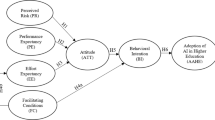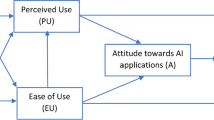Abstract
The integration of Artificial Intelligence (AI) into higher education has the potential to bring new approaches to learning and teaching, but also poses challenges such as ethical concerns and job displacement. To address these challenges, efforts are being made to develop frameworks for the adoption of AI in education. This study investigates the role of AI in higher education in Indian universities, identifies dimensions of AI applications, explores factors influencing the adoption of AI in higher education processes, and develops a framework for the adoption of AI applications by stakeholders in the higher education sector. The study uses a quantitative research design to collect data from students, academics, and management staff at different higher education institutions in India. The technological acceptance model, social cognitive theory, and human–computer interaction theory model are used to understand the factors that influence the acceptance and adoption of AI in higher education institutions in India. The results of the study indicate significant relationships between various factors, including artificial intelligence self-efficacy, behavioural intention to adopt AI, AI adoption in higher education, perceived usefulness, perceived effectiveness, perceived organizational support, and perceived risk. The findings of this study can guide the strategic planning and decision-making related to the integration of AI in higher education and contribute to the understanding of the potential benefits and challenges of AI in education.


Similar content being viewed by others
References
Alam A (2020) Possibilities and challenges of compounding artificial intelligence in India’s educational landscape. Int J Adv Sci Technol 29(5):5077–5094
Anderson G (2020) Students say online classes aren’t what they paid for. https://www.insidehighered.com/news/2020/04/13/students-say-online-classes-arent-what-they-paid
Babbie E (2004) The practice of social research. Wadsworth Publishing Company, Belmont, CA
Baron R, Kenny DA (1986) The moderator–mediator variable distinction in social psychological research: conceptual, strategic, and statistical considerations. J Personal Soc Psychol 51(6):1173
Bhagat S, Kim DJ (2020) Higher education amidst COVID-19: Challenges and silver lining. Info Syst Manag 37(4):366–371
Bhutoria A (2022) Personalized education and artificial intelligence in the United States, China, and India: a systematic review using a human-in-the-loop model. Comput Educ Artif Intell 3:100068
Bodó B, Helberger N, Irion K, Borgesius Zuiderveen FJ, Moller J, van der Velde B, Bol N et al (2017) Tackling the algorithmic control crisis – the technical, legal, and ethical challenges of research into algorithmic agents. Yale J Law Technol 19:133
Bond M, Zawacki-Richter O, Nichols M (2019) Revisiting five decades of educational technology research: a content and authorship analysis. Br J Edu Technol 50(1):12–63. https://doi.org/10.1111/bjet.12730
Carey K (2020) Everybody ready for the big migration to online college? Actually, no. The New York Times. https://www.nytimes.com/2020/03/13/upshot/coronavirus-online-college-classes-unprepared.html?action=click&module=RelatedLinks&pgtype=Article
Chang J, Lu X (2019) The study on students’ participation in personalized learning under the background of artificial intelligence. In: 2019 10th international conference on information technology in medicine and education (ITME). IEEE. pp 555–558
Chao CM (2019) Factors determining the behavioral intention to use mobile learning: An application and extension of the UTAUT model. Front Psychol 10:1652
Chatterjee S (2020) AI strategy of India: policy framework, adoption challenges and actions for government. Transform Gov People Process Policy 14(5):757–775. https://doi.org/10.1108/TG-05-2019-0031
Chatterjee S, Bhattacharjee KK (2020) Adoption of artificial intelligence in higher education: a quantitative analysis using structural equation modelling. Educ Inf Technol 25:3443–3463
Chen YS, Chang CH (2012) Enhance green purchase intentions: The roles of green perceived value, green perceived risk, and green trust. Manag Decision 50(3):502–520
Chen G, Gully SM, Eden D (2001) Validation of a new general self-efficacy scale. Organ Res Methods 4(1):62–83
Chin WW (1998) Commentary: issues and opinions on structural equation modeling. MIS Q 22:vii–xvi
Christensen G, Steinmetz A, Alcorn B, Bennett A, Woods D, Emanuel E (2013) The MOOC phenomenon: Who takes massive open online courses and why? Available at SSRN: https://ssrn.com/abstract=2350964 or https://doi.org/10.2139/ssrn.2350964
Close K, Grebe M, Andersen P, Khurana V, Franke MR and Kalthof R (2020) The digital path to business resilience. https://www.bcg.com/en-us/publications/2020/digital-path-to-business-resilience
Cui W, Xue Z, Thai KP (2019) Performance comparison of an AI-based adaptive learning system in China. In: Proceedings 2018 Chinese automation congress, CAC 2018
Data and artificial intelligence. Advances in intelligent systems and computing, vol 928. Springer, New York, pp 852–859
Dhawan S (2020) Online learning: a panacea in the time of COVID-19 crisis. J Educ Technol Syst 49(1):5–22
Efron B, Tibshirani R (1993) An introduction to the bootstrap, 1st edn. Chapman & Hall/CRC, London, pp 23–29
Eisenberger R, Huntington R, Hutchison S, Sowa D (1986) Perceived organizational support. J Appl Psychol 71:500–507
Fang Y, Ren Z, Hu X, Graesser AC (2019) A meta-analysis of the effectiveness of ALEKS on learning. Educ Psychol 39(10):1278–1292
Fornell C, Larcker DF (1981) Structural equation models with unobservable variables and measurement error: algebra and statistics. J Mark Res 18(3):382–388. https://doi.org/10.1177/002224378101800313
Fu Y (2020) Research on the development trend of online education industry considering the influence of big data and artificial intelligence. Cyber security intelligence and analytics. Springer, New York, pp 852–859
Hair E, Halle T, Terry-Humen E, Lavelle B, Calkins J (2006) Children’s school readiness in the ECLS-K: predictions to academic, health, and social outcomes in first grade. Early Child Res Q 21(4):431–454. https://doi.org/10.1016/j.ecresq.2006.09.005
Hair JF, Ringle CM, Sarstedt M (2013) Partial least squares structural equation modeling: rigorous applications, better results and higher acceptance. Long Range Plan 46(1–2):1–12. https://doi.org/10.1016/j.lrp.2013.01.001
Hair JF, Sarstedt M, Hopkins L, Kuppelwieser VG (2014) Partial least squares structural equation modeling (PLS-SEM): an emerging tool in business research. Eur Bus Rev 26(2):106–121. https://doi.org/10.1108/EBR-10-2013-0128/FULL/HTML
Henseler J, Ringle CM, Sarstedt M (2015) A new criterion for assessing discriminant validity in variance-based structural equation modeling. J Acad Mark Sci 43(1):115–135. https://doi.org/10.1007/S11747-014-0403-8/FIGURES/8
HolonIQ (2020) $74B online degree market in 2025, up from $36B in 2019. https://www.holoniq.com/notes/74b-online-degree-market-in-2025-up-from-36b-in-2019/
Hwang GJ, **e H, Wah BW, Gašević D (2020) Vision, challenges, roles and research issues of artificial intelligence in education. Comput. Educ. Artif. Intell. 1(1):100001
Jaiswal A, Arun CJ (2021) Potential of artificial intelligence for transformation of the education system in India. Int J Educ Dev Using Inf Commun Technol 17(1):142–158
Joshi A, Vinay M, Bhaskar P (2021) Impact of coronavirus pandemic on the Indian education sector: perspectives of teachers on online teaching and assessments. Interact Technol Smart Educ 18(2):205–226
Kim JM (2017) Study on intention and attitude of using artificial intelligence technology in healthcare. J Converg Inf Technol 7(4):53–60
Kline RB (2018) Structural equation modeling. Guilford, New York
Leung M, Sharma Y (2020) Online classes try to fill education gap during epidemic. https://www.universityworldnews.com/post.php?story=2020022108360325
Mason J, Peoples BE, Lee J (2020) Questioning the scope of AI standardization in learning, education, and training. J ICT Standard 8:107–122
Moakofhi, M. K., Phiri, T. V., Leteane, O., & Bangomwa, E. (2019). Using Technology Acceptance Model to Predict Lecturers’ Acceptance of Moodle: Case of Botswana University of Agriculture and Natural Resources
Mugenda AG, Mugenda AG (2008) Social science research: theory and principles. Nairobi Applied 11–22
Natividad, N. J., & Natividad, E. (2021). Preparedness of Elementary School Teachers in the Implementation of Blended Distance Learning: Basis for Technical Assistance. Available at SSRN 3889400
Nunnally J (1967) Psychometric theory. https://psycnet.apa.org/record/2003-00036-000
Ramayah T, Lee J, Business JI-S (2014) Network collaboration and performance in the tourism sector. Serv Bus 5(4):411–428. https://doi.org/10.1007/s11628-011-0120-z
Rivard R (2013) Measuring the MOOC dropout rate. Inside Higher Ed 8:2013
Roll I, Wylie R (2016) Evolution and revolution in artificial intelligence in education. Int J Artif Intell Educ 26:582–599
Roy R, Babakerkhell MD, Mukherjee S, Pal D, Funilkul S (2022) Evaluating the intention for the adoption of artificial intelligence-based robots in the university to educate the students. IEEE Access 10:125666–125678. https://doi.org/10.1109/ACCESS.2022.3225555
Sandu N, Gide E (2019) Adoption of AI-chatbots to enhance student learning experience in higher education in India. In: 2019 18th international conference on information technology based higher education and training (ITHET). IEEE, pp 1–5
Shum SJB, Luckin R (2019) Learning analytics and AI: politics, pedagogy and practices. Br J Edu Technol 50(6):2785–2793
Southgate E (2020) Artificial intelligence, ethics, equity, and higher education: a ‘beginning-of-the-discussion’ paper
Spolaôr N, Benitti FBV (2017) Robotics applications grounded in learning theories on tertiary education: a systematic review. Comput Educ 112:97–107
Steps taken by the Government to use artificial intelligence for education transformation (2021) Press information bureau, Government of India, Ministry of Education. https://pib.gov.in/Pressreleaseshare.aspx?PRID=1704878
Subedi S, Nayaju S, Subedi S, Shah SK, Shah JM (2020) Impact of E-learning during COVID-19 pandemic among nursing students and teachers of Nepal. Int J Sci Healthc Res 5(3):68–76
Tanenbaum C (2016) STEM 2026: a vision for innovation in stem education. Office of Innovation and Improvement US Department of Education, Washington, District of Columbia
Walkington C, Bernacki ML (2020) Appraising research on personalized learning: definitions, theoretical alignment, advancements, and future directions. J Res Technol Educ 52(3):235–252
Woolf BP, Arroyo I, Muldner K, Burleson W, Cooper DG, Dolan R, Christopherson RM (2010) The effect of motivational learning companions on low achieving students and students with disabilities. In: International conference on intelligent tutoring systems. Springer, New York, pp 327–337
Woolf BP, Lane HC, Chaudhri VK, Kolodner JL (2013) AI grand challenges for education. AI Mag 34(4):66–84
Yau HK, Ho TC (2015) The influence of subjective norm on behavioral intention in using e-learning: An empirical study in Hong Kong higher education. In: Proceedings of the International MultiConference of Engineers and Computer Scientists, vol 2, pp 18–20
Yilmaz B (2018) Effects of adaptive learning technologies on math achievement: a quantitative study of ALEKS math software. Dissertation abstracts international section A: humanities and social sciences
Yu J, Jee Y (2020) Analysis of online classes in physical education during the COVID-19 pandemic. Educ Sci 11(1):3
Zhang W, Gutierrez O (2007) Information technology acceptance in the social services sector context: an exploration. Soc Work 52(3):221–231. https://doi.org/10.1093/sw/52.3.221
Zikmund WG, Babin BJ, Carr JC, Griffin M (2013) Business research methods. Cengage Learning, Boston
Zheng L, Cui P, Li X, Huang R (2018) Synchronous discussion between assessors and assessees in web-based peer assessment: Impact on writing performance, feedback quality, meta-cognitive awareness and self-efficacy. Assess Eval Higher Edu 43(3):500–514
Funding
No funding was received for conducting this study.
Author information
Authors and Affiliations
Corresponding author
Ethics declarations
Conflict of interest
The authors declare that they have no known competing financial interests or personal relationships that could have appeared to influence the work reported in this paper.
Human or animals rights
The authors declare that this study does not involve use of any animal or human participant during the process of the entire study. Only respondents have participated in the survey of research totally on voluntary basis.
Informed consent
In the research conducted, the participation of the respondents was totally on voluntary basis understanding the purpose of the study. Authors adhered to the strict ethical guidelines related to the privacy and confidentiality of their personal information and responses to the survey.
Additional information
Publisher's Note
Springer Nature remains neutral with regard to jurisdictional claims in published maps and institutional affiliations.
Rights and permissions
Springer Nature or its licensor (e.g. a society or other partner) holds exclusive rights to this article under a publishing agreement with the author(s) or other rightsholder(s); author self-archiving of the accepted manuscript version of this article is solely governed by the terms of such publishing agreement and applicable law.
About this article
Cite this article
Sharma, S., Singh, G., Sharma, C.S. et al. Artificial intelligence in Indian higher education institutions: a quantitative study on adoption and perceptions. Int J Syst Assur Eng Manag (2024). https://doi.org/10.1007/s13198-023-02193-8
Received:
Revised:
Accepted:
Published:
DOI: https://doi.org/10.1007/s13198-023-02193-8




